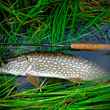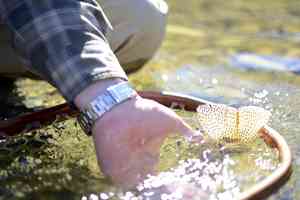G. Loomis has a long pedigree of making some of the finest fly rods on the market. It’s a pedigree that began with founder and original rod designer Gary Loomis and continued relatively unabated with fly casting freak-of-nature and Rajeff brother, Steve Rajeff. If you’re not familiar with the Rajeff brothers, they’re sort of like the Hanson Brothers, except they don’t have stupid haircuts and they’re actually good at something. Oh, and they can toss casts to the goddamned moon.
Over the years, Loomis built rods like the IMX—which has often been credited with being the original spark that lit the fly rod “arms race”—the GLX and, most recently, the NRX. These rods and other Loomis creations have long been venerated by countless anglers as the finest rods on the market. Just ask Loomis owners. They know. And if you don’t, you’re probably casting one of those other "best" rods on the market. Poor you.
But then a funny thing happened. After years of cranking out rods that most anglers lusted after, Loomis disappeared—just walked into the woods one day and never came back.
Okay, not really. But you get the idea. Loomis stopped doing much that was new. Their marketing slipped. The shops stopped pushing Loomis rods. NRXes kept leaving the factory and along the way Loomis turned out the PRO4x line—which, by the way, is a pretty good rod—but, in many ways, Loomis went dark. George Anderson kept standing on mountain tops in Yellowstone, yelling that the NRX LP remained the best fly rod on the market, but it’s not clear whether anyone bothered to listen.
And then, unexpectedly, Loomis announced mid-last year that it was introducing its first new flagship rod in many years. Unfortunately, it seemed like one that, from the start, was destined for failure in oh, let me count the ways.
It was $1,000, a price barrier no major production rod had ever broken before. It was co-branded with the Shimano name which, sure, might be Loomis’ parent company, but is a wince-inducing name to hoity toity fly anglers who decry anything from the world of conventional fishing, regardless of how asinine that line of thinking is. And as icing on the cake, Loomis gave it a hopelessly stupid name: Asquith.
So it seemed that Loomis’ big announcement and gusto-filled return to the spotlight of the fly fishing world would fizzle out before its fire really got started. And it likely would have, had it not been for one minor detail: the Asquith absolutely kills.
What Works
While the Asquith has new, unique tapers that Rajeff based on previous successes, much of what is new about the Asquith revolves around its construction and materials—which features parent company Shimano's Spiral X technology. As we noted when we wrote about the Asquith back in July, Shimano has a lot of fancy words — ones like "InfinityTape" and "Musclecarbon" — that it uses to describe exactly what Spiral-X is and what it does, but here's the gist: Spiral X blanks are built using layers of carbon fibers laid in alternating directions. The result is a three layer structure featuring an inner and outer layer cross-wrapped on opposing axes, with a straight or longitudinal middle layer. According to Loomis, this patented construction process significantly increases rod rigidity and reduces torsional motion (twist) without adding weight. Spiral X also allows for a thin wall blank, which reduces rod ovalization. If you're not familiar with rod ovalization, don't worry, most people aren't. It's a worry of big fish fighters — in the fly world think big steelhead, tarpon, barracuda, false albacore and so on — put simply, rods that feature less ovalization are less likely to break under big loads.
Craftsmanship/Appearance
Is the craftsmanship and appearance of the Asquith as fine as you'd expect it to be for a $1,000 rod? You might find yourself wanting if you dropping four figures on a fishing rod leaves you craving hand numbering and calligraphy. That aside, the cork is superb, the reel seat is one of the nicest I've ever seen and the finish on the rod is excellent.
Weight
In my opinion, weight is an overvalued evaluator of fly rods. I hate talking about it. But damn it if rods don't keep getting lighter—both in ounces and swing weight, but primarily the latter. If you're not familiar with swing weight, it's another term for an object's MOI (moment of inertia) and it measures how resistant an object is to acceleration. Put more simply, swing weight is a way of relating how heavy a fly rod feels when you're casting it, not when it's hanging on the rack at the store. You care about swing weight. Actual weight? Not so much.
The Asquith is shockingly light. Both in actual weight and swing weight. In fact, I've not cast a rod that can match the Asquith in this category. And while I maintain that weight is overvalued as a yard stick to measure fly rods by, the Asquith's low swing weight adds to its versatility, overall feel and is an asset—particularly in heavier weights.

Accuracy
Accuracy is where the Asquith really shines. And that's saying something, especially considering the company that the Asquith keeps at the flagship end of the fly rod market. For my money, accuracy is the one area where, over the last few years, rods have brought the biggest improvements to the table. Due to technological advancements in materials and construction, rod makers continue to produce rods with better torsional stability and tracking and thus better accuracy. Put most simply, the Asquith goes where you tell it to. I've fished several models throughout the range, anywhere from the 9' 5 and 7 weights to the 6 weight two hander, and the Asquith's accuracy its the hallmark of each. Whether casting tiny dries, flinging nymph rigs or even, inexplicably, hucking depth-charging dolly llamas on sinking tips, something no one expects any fly rod to handle with any measure of grace, yet somehow the Asquith manages to do just that.
Power
Especially given the Asquith's low swing weight, the power it offers may be second-to-none in the industry. I can't chuck effortless, 100-foot casts like the Rajeff brothers can, but I can tell you that I've yet to find a situation in which the Asquith didn't feel like it had more to give than I could get out of it. Whether in fishing situation or just screwing around to see how long I could throw it, the limitation to the distance the Asquith would produce was always the caster (me), never the rod. Superior casters whose hands I put the rod in echoed my thoughts.
Action
Chances are, if you've developed enough interest in the Asquith to find yourself reading a review of it, you already know that the Asquith is a fast-action rod. And knowing that isn't all that useful. Rod actions in the "fast-action" realm have become much more nuanced over the last few years—and that's a good thing. Knowing whether a rod is "fast" or "medium-fast" doesn't tell you much at all these days. That said, if you still find yourself craving an answer on just where the G. Loomis Asquith sits on the spectrum, peg it somewhere between fast and medium-fast. Somewhere between Loomis' NRX and NRX LP, though likely closer to the LP.
More importantly, the Asquith has a quick, responsive, progressive action that lets you effortlessly load the rod—and feel that load—throughout your casting range. Like many other recent introductions in the fast-action, flagship realm, the Asquith has a softer, more lively-tip than the somewhat lifeless fast-action rods of 5 or so years ago.
The aforementioned power that the Asquith possesses isn't just there, it's accessible. You don't have to dig for it, even at longer distances. And in close, the Asquith is no slouch either. You might hear other folks note that the Asquith lacks some sensitivity in close—but I've never met a fast-action rod that didn't. For its part, howeer, the Asquith somehow manages to offer the same accuracy in close as it does at 40, 50 or 60 feet—and in my experience, often far more than medium or slow-action rods that are designed with shorter casting distances in mind. Make no mistake, the Asquith is a rod you can fish at almost any distance.
Feel
Action is a characteristic that folks love to talk about when evaluating rods. As above, is the rod fast or medium-fast? Or medium or slow? What about recovery? Does the rod recover quickly or slowly? But feel is one of those characteristics of a fly rod that some scoff at, claiming it is far too subjective to be a useful metric either in evaluating a rod's performance or in comparing it to other rods. You'll often see "feel" used to describe whether the rod gives feedback at certain casting distances (whether it bends, in other words), but less often used as an overarching term to describe the general experience of casting a particular rod. Feel, some folks argue, is far too eye-of-the-beholder to be useful. This is stupid thinking, and an even stupider thing to say.
Not only is virtually every method of evaluating a fly rod subjective, the overall impression one has of a fly rod is an amalgamation of those subjective evaluations. At the end of the day, how much I enjoy fishing a particular rod is based on my own subjective interpretations of all those bits and pieces—weight, action, recovery, power, torsional stability and so on. Sure, we can measure some of those things but we almost never do. And when we do, does anyone care? Honestly, when was the last time you bought a fly rod because of its deflection chart or how it performed on an Instron machine? Instead, when we discuss our opinions on a particular fly rod, we relate our opinions on each of these aspects and combine them to talk, ultimately, about how a rod feels. That said, to me, a rod's "feel" is its most important characteristic.
On one other occasion, for a rod that remains one of my favorite trout rods of all time, I've related an anecdote from a far superior angler and friend once told me that you should pick a rod that "does what you need quickly and effortlessly, without you needing to think about it, one that disappears in your hand." A rod that does all of those things is one that "feels" just right. It isn't just light, doesn't just have enough power, nor does it just give you excellent accuracy, or versatility. It gives you all of those things, in a way that's just right for your fishing style. For me, the Asquith is one of those rare rods that does just that.
What Doesn't
Price
The Asquith costs $1,000. For a single-handed freshwater model. A saltwater trick-out will cost you another $100-$200 and a two-hander will run you another $100-200 on top of that. No mass production, single-handed rod has ever broken that 4-figure barrier before. So, can a rod really be worth $1,000?
If you find yourself asking that question, you're likely not very good at critical thinking. After all, is paying $1,000 for a fly rod meaningfully different than paying $945? Or $895? Or $845? Of course not. While the sticker shock of that fourth digit might cause Loomis some headaches, the question to ask is whether the value high-end fly rods offer is adequate to justify cost difference when compared with their mid-range counterparts, which typically cost anywhere from 40-50% less.
Final Word
I've been fishing the Asquith for the better part of a year now, but it was within the first few moments of fishing the Asquith that I knew not just that my guesses about Loomis' return to the spotlight being destined for failure were wrong, but foolish. After all, as noted, Loomis has spent the last 30 years delivering some of the finest rods the fly fishing world has ever seen. What was the likelihood that Loomis and Rajeff were going to turn out an awkwardly-named dud?
Instead, in the Asquith, Loomis has given us just what we might have expected had they named the Asquith the "ZRX" or some other equally-meaningless-but-less-peculiar-sounding name and had done it a couple years sooner—a rod that pushes the boundaries of materials and technology and offers us what is likely destined to become another classic amongst Loomis' long-running pedigree. And, if I'm being really honest, that odd name just doesn't sound that odd anymore. Maybe it's growing on me.
Not only is the Asquith sure to grab a share of the spotlight, it might just hog it.






























Comments
Flykuni of California replied on Permalink
Well, nice review, but for 1000. clams I'm buyin' a fine split cane rod that will not lose value when it first sees water, or a fish. And may increase in value over time. So there. Natural fibers win again over the test tubular creations of the toxic extrudings in the laboratory.
Weston replied on Permalink
Great review.
I am interested in this rod 905 and the Stickman P5 that you reviewed. Taking price out of the equation, just two rods that you have fished and you get to keep one. Which would you choose? Typically I form my own opinion but Asquith is hard to find and P5 impossible, without ordering. I understand if you can't say but your opinion is appreciated. -W
Chad Shmukler replied on Permalink
Unfortunately, Weston, that's too tough a call to make. I know that's not terribly helpful, but it's the truth. On one hand, which is the better rod for you is totally dependent on your and your particular casting style and preferences. Additionally, I haven't fished my beloved P5 in at least a year and have never fished the Asquith and the P5 side by side ... and so it would be unfair for me to make a comparison. If that's ducking the question, then I'm guilty as charged.
Jeremy replied on Permalink
Highly enjoyed the review! Thanks for the wit and making it fun. Looking forward to more of your writing. Can't wait to pick up an Asquith Spey. Love the NRX two handers very much. Steves tapers are remarkable. The genius behind them is that they can make anyone cast like a seasoned pro immediately. In addition you can feel the fly ticking along in the water columns and every leaf, rock, change in current, or nibble the fly encounters. It's all in the tip baby
jason replied on Permalink
thnks for this very well written and accurate article....2 days ago, I went to pick up a 5wt NRX LP from the fly shop....I decided to cast the Asquith, just because....after casting the NRX LP, I thought...you can't get anymore from a 5wt...but I was wrong...the Asquith is noticeably better in 2 aspects: 1) it feels much lighter to cast and 2) longer distances require much less effort. I took the Asquith on a float trip that afternoon...the "light" casting feel translates to pure fun when you catch fish....fighting a fish on a Asquith 5wt felt more like a 4wt or 3wt.....it's pretty awesome.
It would be a major accomplishment to buy a bad rod @ $1000 or even half that price...but this rod is pretty special....
again, awesome review.
jason
Pages